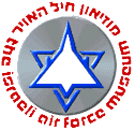The First IAF Fighter Mission
Stopping An Egyptian Column Near Ashdod
On 29 May 1948, an Egyptian column, numbering some 500 armored vehicles and cannons, crossed Kibbutz Nitzanim on its way northward, towards Tel Aviv. The Egyptian column advanced toward Ashdod. If the Egyptian force would not be halted at Ashdod, it would be able to continue its advance to Tel Aviv. Therefore, the IDF General Staff decided to strike hard at the advancing column and employ aircraft for the first time. With little to defend itself in May '48, Israel hurriedly purchased a number of second rate Czech-made Messerschmitts. The planes were taken apart, transported to Israel at night, and secretly reassembled at Ekron (later to become Tel Nof AFB). The first pilots hoped to employ this force against the main Egyptian air threat based at El Arish. Yet fate had other plans for them.
An Egyptian column of some 500 vehicles was making its way up the Coastal Road towards Tel Aviv. The column halted briefly at a bombed-out bridge near Ashdod. Barely 20 miles separated the enemy from its objective. With no alternative, the first four fully assembled planes were pressed into action. Lou Lenart, an experienced American volunteer, was selected to lead the historic mission. He was joined by Moddy Alon, Ezer Weizmann and Eddie Cohen. Each plane swooped down on the enemy with two 70-kg bombs. They continued to strafe the column despite the heavy ground fire. Unfortunately, the Messerschmitts' untested 20 mm cannons and machine guns jammed quickly and the few rounds that they fired didn't inflict much damage. But the psychological effect was enormous. The surprised Egyptians scattered for cover in the face of a bona fide aerial attack. By the time they regrouped, they had lost the offensive. Israel's outnumbered Givati forces seized the opportunity to launch a counterattack and stopped the advance in its tracks. The bombed-out bridge later became known as Gesher Ad Halom (Until Here). The price of success was high: Eddie Cohen, a South African-born pilot, was killed when his Messerschmitt crashed and burned. As a result, the First Fighter Squadron lost one-fourth of its pilots on its maiden combat sortie. This was to set the tone for the future: achieving the mission despite personal sacrifice.
11 June: Disconnecting the Negev
Since the Egyptians forfeited their advance northward, they devoted all
their efforts to securing their rear lines and arteries of transportation.
On 7 June, the Egyptians attacked kibbutz Nitzanim, located south of Ashdod.
The first attempt to break through was repelled by the kibbutz defenders.
After extensive fighting, and after taken heavy losses, the 150 Nitzanim
defenders were forced to surrender. In the battle for Nitzanim, the Egyptians
managed to capture Hill 69, a key position controlling the road to the
Ashdod area, and the Egyptians endeavored to sweep on towards Beer Tuvia.
But here the defenders stood firm. The main Egyptian objective now was
to cut off the Negev completely from the north and to lend added emphasis
to the eastern Egyptian push via Hebron and Bethlehem towards Jerusalem.
Accordingly, the Majdal-Faluja-Beit road became vitally important as a
lateral axis- it would both seal off the Negev from the north and enable
the Egyptian forces to reinforce their eastern effort on the Beersheba-Hebron-Jerusalem
road. On the eve of the cease-fire (the night of 10-11 June) the "Givati"
Brigade achieved a number of tactical victories and succeeded in cutting
off the Egyptian "desert road" from 'Uja to Beersheba.



